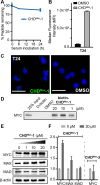Proteomimetic Strategy for the Modulation of Intrinsically Disordered Protein MYC
- PMID: 40198840
- PMCID: PMC12022973
- DOI: 10.1021/jacs.4c18144
Proteomimetic Strategy for the Modulation of Intrinsically Disordered Protein MYC
Abstract
The difficulty in developing specific ligands for protein receptors is directly correlated to the presence of unique binding sites on the protein surface. Conformationally dynamic proteins increase the level of difficulty in ligand design, and the challenge is further exacerbated for proteins that are intrinsically disordered. Intrinsically disordered proteins (or IDPs) do not adopt a fixed three-dimensional shape until they bind their target; an absence of organized binding sites underscores the difficulty in developing synthetic ligands for these proteins. We hypothesized that one avenue for the development of binders for a disordered region would be to trap one of its thermodynamically accessible conformations in a receptor. Here, we show the application of this approach to MYC, which represents a critical therapeutic target but has not yielded small-molecule inhibitors due to its conformationally dynamic nature. MYC adopts a helical configuration when it binds to its cellular partner MAX. We rationally designed a proteomimetic scaffold to trap this conformation. We show that MYC can be directly engaged in both biochemical and cellular assays. Overall, this work demonstrates a general method to capture and trap intrinsically disordered proteins with a propensity to adopt α-helical conformations.
Conflict of interest statement
The authors declare the following competing financial interest(s): The crosslinked helix dimers technology has been licensed to Dimericon Therapeutics. PSA is a cofounder of Dimericon.
Figures




Similar articles
-
NMR-identification of the interaction between BRCA1 and the intrinsically disordered monomer of the Myc-associated factor X.Protein Sci. 2024 Jan;33(1):e4849. doi: 10.1002/pro.4849. Protein Sci. 2024. PMID: 38037490 Free PMC article.
-
Systemic treatments for metastatic cutaneous melanoma.Cochrane Database Syst Rev. 2018 Feb 6;2(2):CD011123. doi: 10.1002/14651858.CD011123.pub2. Cochrane Database Syst Rev. 2018. PMID: 29405038 Free PMC article.
-
Structural dynamics of IDR interactions in human SFPQ and implications for liquid-liquid phase separation.Acta Crystallogr D Struct Biol. 2025 Jul 1;81(Pt 7):357-379. doi: 10.1107/S2059798325005303. Epub 2025 Jun 27. Acta Crystallogr D Struct Biol. 2025. PMID: 40574713 Free PMC article.
-
Adapting Safety Plans for Autistic Adults with Involvement from the Autism Community.Autism Adulthood. 2025 May 28;7(3):293-302. doi: 10.1089/aut.2023.0124. eCollection 2025 Jun. Autism Adulthood. 2025. PMID: 40539213
-
The Black Book of Psychotropic Dosing and Monitoring.Psychopharmacol Bull. 2024 Jul 8;54(3):8-59. Psychopharmacol Bull. 2024. PMID: 38993656 Free PMC article. Review.
References
-
- Henderson A. R.; Henley M. J.; Foster N. J.; Peiffer A. L.; Beyersdorf M. S.; Stanford K. D.; Sturlis S. M.; Linhares B. M.; Hill Z. B.; Wells J. A.; Cierpicki T.; Brooks C. L.; Fierke C. A.; Mapp A. K. Conservation of coactivator engagement mechanism enables small-molecule allosteric modulators. Proc. Natl. Acad. Sci. U.S.A. 2018, 115, 8960–8965. 10.1073/pnas.1806202115. - DOI - PMC - PubMed
-
- Kurgan L.; Hu G.; Wang K.; Ghadermarzi S.; Zhao B.; Malhis N.; Erdős G.; Gsponer J.; Uversky V. N.; Dosztányi Z. Tutorial: a guide for the selection of fast and accurate computational tools for the prediction of intrinsic disorder in proteins. Nat. Protoc. 2023, 18, 3157–3172. 10.1038/s41596-023-00876-x. - DOI - PubMed
MeSH terms
Substances
Grants and funding
LinkOut - more resources
Full Text Sources

